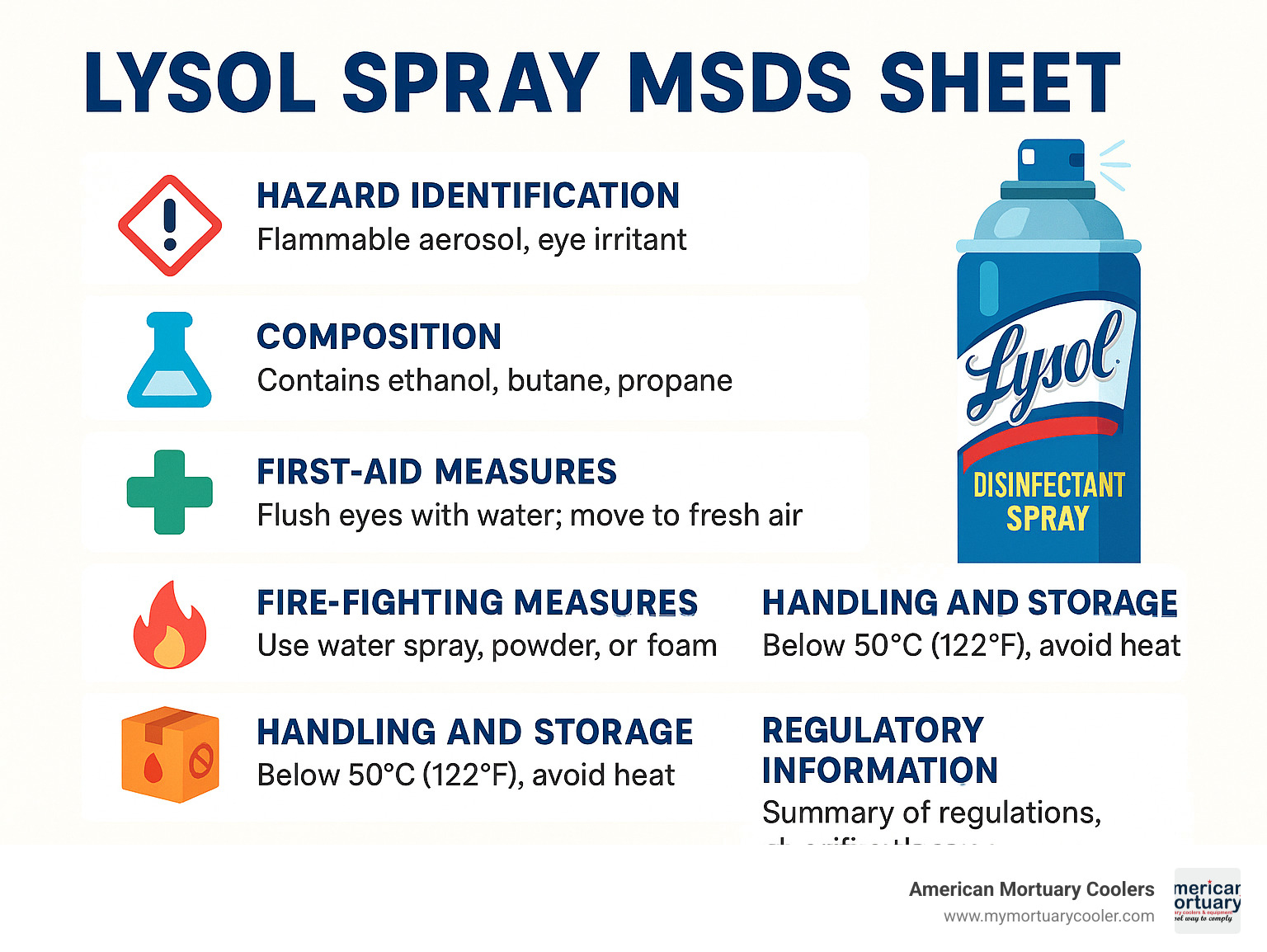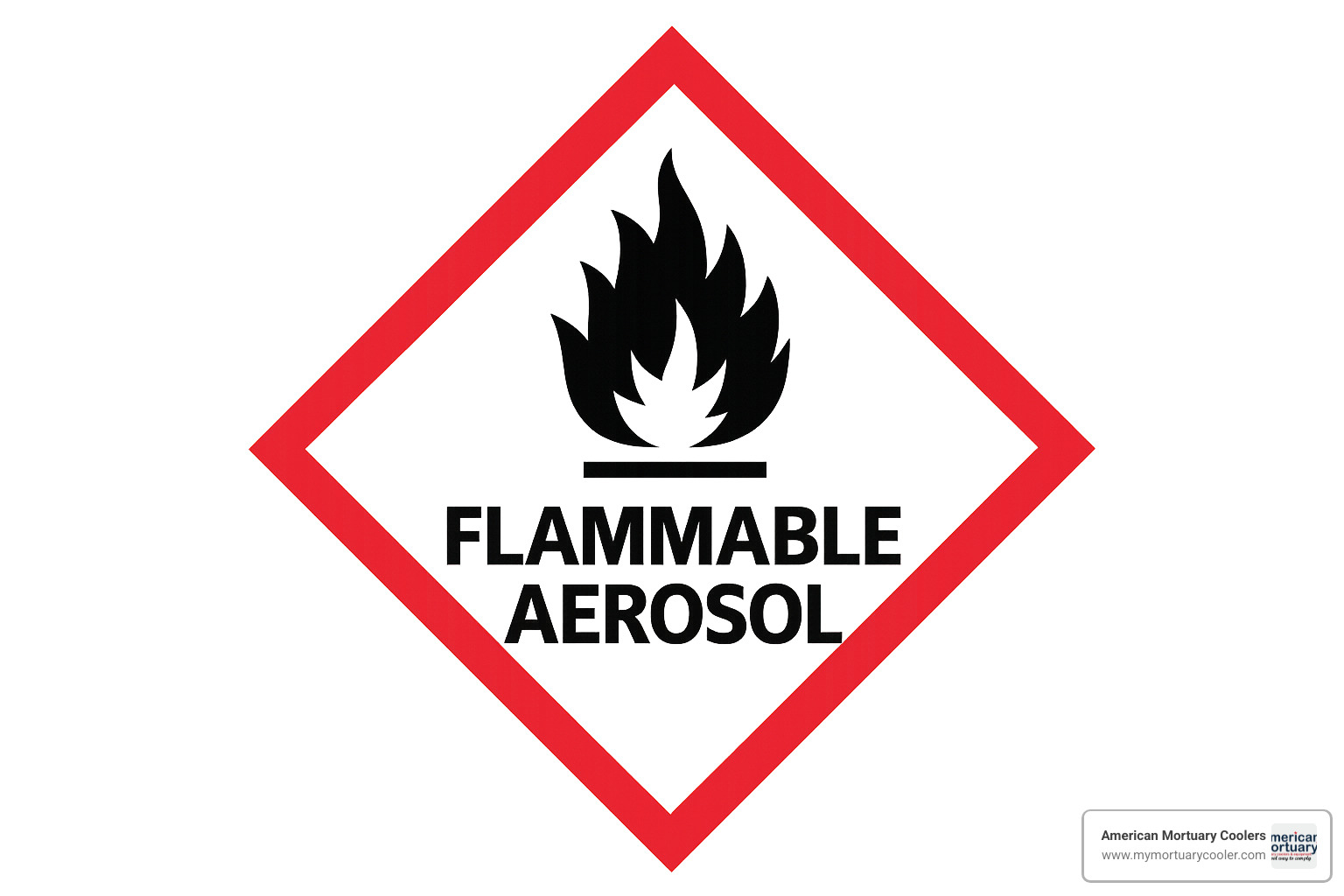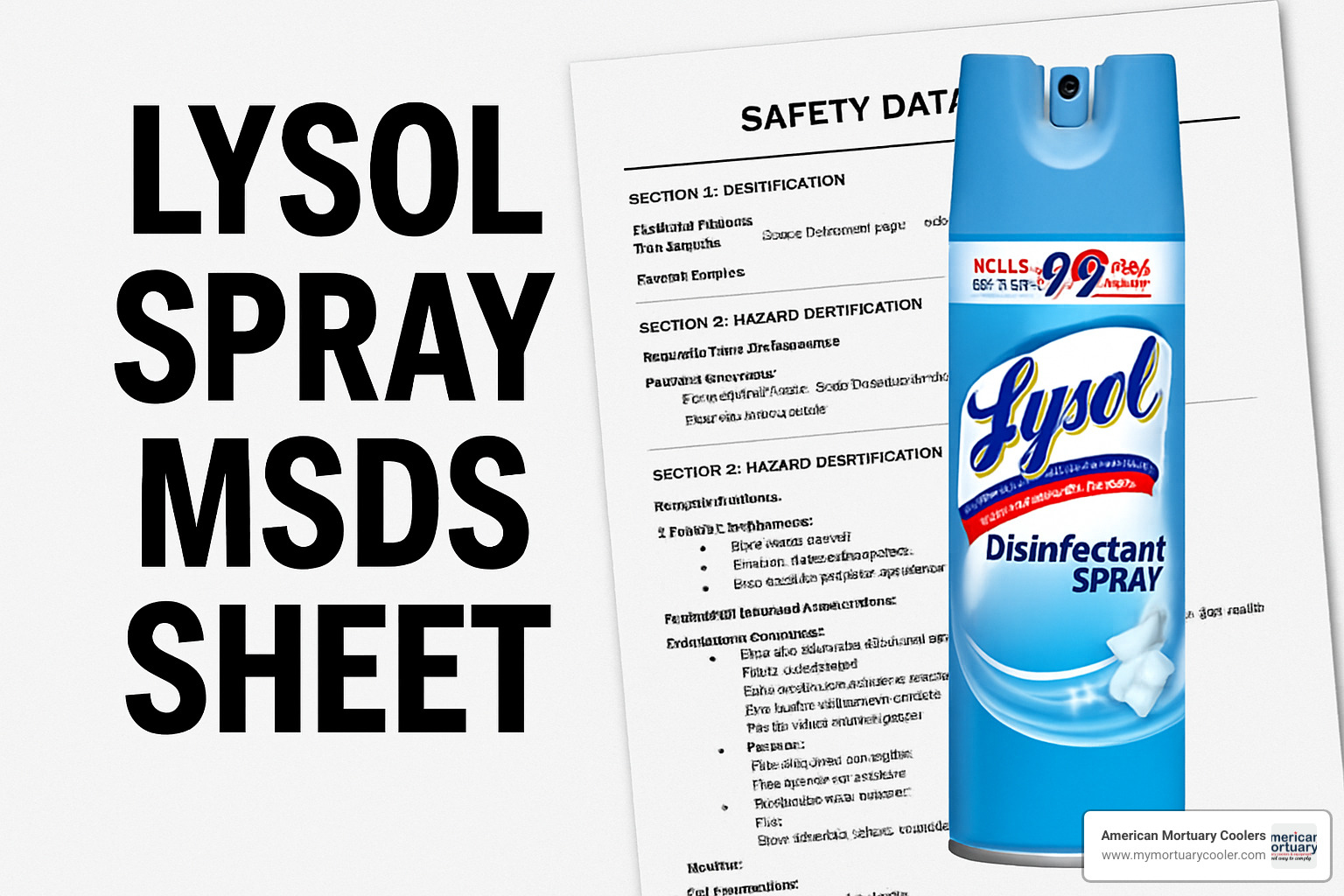
The Complete Guide to Lysol Spray MSDS Sheets
Why Understanding Lysol Spray MSDS Sheets Is Critical for Safe Facility Operations
A lysol spray msds sheet (Material Safety Data Sheet) provides comprehensive safety, handling and hazard information for Lysol Disinfectant Spray products used in workplace settings. The MSDS contains 16 sections of critical data including chemical composition, first-aid measures, fire-fighting procedures and personal protective equipment (PPE) requirements.
Key Information You’ll Find on a Lysol Spray MSDS Sheet:
- Chemical Composition: 30-60 % ethanol, 5-10 % butane, 1-5 % propane
- Primary Hazards: Flammable aerosol (Category 2), gas under pressure, eye irritant
- Flash Point: 18.6 °C (65.5 °F) – highly flammable
- Storage Requirements: Keep below 50 °C (122 °F), away from heat sources
- PPE Requirements: Chemical-resistant gloves, splash goggles, adequate ventilation
- First Aid: Flush eyes for 15 + minutes, move to fresh air if inhaled
Every facility using Lysol spray must have the current MSDS readily available to comply with OSHA’s Hazard Communication Standard (29 CFR 1910.1200). This applies especially to funeral homes, mortuaries and healthcare facilities where staff regularly use disinfectants for surface cleaning and odor control.
The distinction between consumer product labels and workplace MSDS sheets is crucial. While consumer labels provide basic precautions, the MSDS offers detailed technical data needed for professional use, emergency response and regulatory compliance.
I’m Mortuary Cooler from American Mortuary Coolers, and I’ve worked extensively with funeral-home directors on proper disinfection protocols for mortuary equipment, including the safe use of products covered by lysol spray msds sheet requirements.

Related resources for funeral professionals:
Understanding the Lysol Spray MSDS Sheet
When you pick up a can of Lysol spray at home, you see basic safety warnings. But in the workplace? That's where the lysol spray msds sheet becomes essential. This comprehensive document goes beyond simple consumer labels to provide technical details needed for safe professional use.
The MSDS follows a strict 16-section format covering everything from chemical composition to emergency procedures. The difference between a consumer label and workplace MSDS is significant - you get complete safety information rather than basic warnings.
Here's what's inside that can: 30-60% ethanol (the main disinfecting ingredient), 5-10% butane, and 1-5% propane as propellants. This combination creates a flammable aerosol, which is why you'll see the signal word "Danger" prominently displayed along with GHS pictograms - the flame symbol and gas cylinder.
The flash point of 18.6°C (65.5°F) is critical to remember. This product can ignite at surprisingly low temperatures. I've worked with funeral homes where staff stored aerosols near heating units without realizing the risk.
| Consumer Label | Workplace SDS |
|---|---|
| Basic precautions | Detailed hazard data |
| Simple ingredients list | Exact percentages & CAS numbers |
| General first aid | Specific medical protocols |
| Keep away from heat | Flash point: 18.6°C |
| Basic storage tips | Storage below 50°C required |
Why Every Facility Needs a Lysol Spray MSDS Sheet
OSHA's Hazard Communication Standard requires accessible lysol spray msds sheet documentation. This isn't just compliance - it's about keeping your people safe and creating informed safety protocols.
The MSDS becomes the foundation for training programs, emergency procedures, and daily safety protocols. Facilities that maintain current, accessible MSDS sheets consistently show better safety records.
What Hazards Are Listed on a lysol spray msds sheet?
The main hazards listed are flammable aerosol (Category 2), gas under pressure, and eye irritation (Category 2B). These classifications translate into real precautions needed daily.
The gas under pressure classification is particularly important for storage. Keep cans below 50°C (122°F) or risk container rupture. Understanding these hazards helps create safer work environments for disinfecting mortuary coolers and maintaining facility cleanliness.
Key Safety Information Breakdown
When reviewing a lysol spray msds sheet, the composition section provides detailed ingredient breakdown essential for safety. Each chemical component gets a CAS (Chemical Abstracts Service) number for regulatory tracking.
The main component is ethanol (CAS 64-17-5) at 30-60% by weight, providing disinfecting power while creating flammability concerns. Butane (CAS 106-97-8) at 5-10% and propane (CAS 74-98-6) at 1-5% serve as propellant gases. Some formulations include quaternary ammonium compounds at 0-0.1%.
Understanding these percentages guides safety measures. The ethanol provides cleaning power but requires keeping products away from heat sources. Propellant gases create pressure and add to fire risk.
LC50 values indicate toxicity levels. For ethanol, the oral LD50 in mice is 3,450 mg/kg and inhalation LC50 in rats is 31,623 ppm. These numbers help establish safe exposure limits and emergency response procedures.
For comprehensive equipment maintenance guidance, check out our detailed guide on maintaining and cleaning your mortuary cooler for longevity.
First-Aid Measures in the lysol spray msds sheet
The first aid section provides step-by-step procedures for different exposure types.
For eye contact, hold the eyelid open and rinse slowly with water for 15-20 minutes. Remove contact lenses after 5 minutes if they come out easily, then continue rinsing. Extended flush time is essential due to ethanol content.
Skin contact requires removing contaminated clothing immediately and rinsing affected areas with water for 15-20 minutes. Inhalation exposure means getting the person to fresh air immediately and keeping them comfortable.
If someone ingests the product, rinse mouth with water, don't induce vomiting, and contact a doctor or poison control center immediately.
Recommended PPE & Exposure Controls
Your lysol spray msds sheet specifies required protective equipment: chemical-resistant, impervious gloves and chemical splash goggles. For normal use with good ventilation, respiratory protection typically isn't needed.
If ventilation is inadequate or airborne concentrations exceed limits, appropriate respiratory protection becomes necessary.
OSHA limits are 1,000 ppm for ethanol as an 8-hour time-weighted average, with ACGIH agreeing on the same limit. For butane, OSHA sets the limit at 800 ppm over 8 hours.
Engineering controls should include adequate general or local exhaust ventilation to control airborne concentrations.
Fire & Explosion Data

The fire section contains life-saving emergency information. With a flash point of 18.6°C (65.5°F) and heat of combustion of 17.99 kJ/g, Lysol spray presents serious fire hazards.
The ignition distance for aerosol spray is less than 45.72 cm, meaning flames can travel back to containers from seemingly distant ignition sources. Consider pilot lights, electrical equipment, and other potential ignition sources.
For firefighting, use water spray to cool fire-exposed containers while using appropriate extinguishing media for surrounding fires. The product falls under UN1950 classification for aerosols and DOT Class 2.1 flammable gas regulations.
Container rupture when heated creates serious safety risks, as containers can become projectiles. Proper storage protocols must account for these risks, including separation from heat sources and safe handling procedures.
Handling, Storage, and Spill Response
Proper handling of Lysol spray starts with understanding you're dealing with a flammable aerosol. Keep it away from anything that could spark or create heat - no smoking, open flames, or sparks from electrical equipment.
Storage requirements are straightforward but critical. Keep containers below 50°C (122°F) in cool, well-ventilated areas away from direct sunlight. Many facilities incorrectly store aerosols in utility rooms that get uncomfortably hot.
In mortuary settings with electrical equipment and metal surfaces, explosion-proof electrical equipment and non-sparking tools become essential when handling bulk quantities. Anti-static clothing and grounding procedures help prevent static discharges that could ignite vapors.
Never puncture or incinerate containers, even when empty. Pressurized containers retain both pressure and flammable residues. Proper disposal through licensed waste contractors is the only safe option.
For comprehensive safety protocols that complement proper disinfectant handling, check out our guide on essential safety protocols for morgue freezers.
Accidental Release Procedures
When spills occur, first priority is evacuating the area and eliminating all ignition sources. Turn off electrical equipment, extinguish flames, and ensure no smoking nearby. Vapors can travel considerable distances to find ignition sources.
Response teams need proper PPE: chemical-resistant gloves, splash goggles, and respiratory protection if ventilation is inadequate. Ventilate the area immediately to prevent vapor buildup.
For cleanup, use inert absorbent materials like sand, earth, vermiculite, or diatomaceous earth. Avoid materials that might create static electricity. Collect everything in properly labeled containers for licensed waste contractor disposal.
Environmental protection means keeping spilled material away from waterways, sewers, and confined spaces. Large spills may require professional hazmat teams.
Where to Find the Latest lysol spray msds sheet Online
Finding current lysol spray msds sheet information is straightforward. EPA registration number 777-99 helps identify specific product formulations. Reckitt Benckiser maintains current sheets through their rbnainfo smart-label system.
For professional users needing complete workplace compliance documentation, the Professional SDS PDF contains the full 16-section OSHA-required format.
Set up periodic MSDS update systems - formulations and requirements change regularly. Smart facilities maintain both printed copies for emergency access and digital copies for training and distribution.
Regulatory & Environmental Considerations
Understanding regulatory requirements for your lysol spray msds sheet is straightforward once you know what to look for.
OSHA's Hazard Communication Standard (29 CFR 1910.1200) requires every facility using Lysol spray to have current MSDS readily available and train employees on its contents. It's not just about having paperwork - your team needs to understand the document.
EPA oversees disinfectant claims under registration number 777-99. When Lysol claims their spray kills 99.9% of viruses and bacteria, EPA has verified those claims through rigorous testing.
SARA Title III sections 311 and 312 apply to facilities storing significant quantities of hazardous materials. These reporting requirements help local emergency responders understand what chemicals are present in your facility.
California's Proposition 65 adds complexity. While ethanol is listed under Prop 65 as causing reproductive harm, specific warning requirements depend on exposure levels and use patterns.
Environmental considerations deserve attention, especially for community-focused facilities like funeral homes. Quaternary ammonium compounds in some Lysol formulations can persist in aquatic environments, making proper disposal critical.
Aquatic toxicity data shows these compounds affect fish and aquatic life at relatively low concentrations. Proper disposal through licensed contractors ensures environmental regulation compliance while protecting communities.
For latest scientific research on SARS-CoV-2 efficacy and pathogen control, EPA maintains current data at EPA's coronavirus guidance.
Transportation & Labeling Requirements
Transportation regulations treat Lysol spray as DOT UN1950 classification - an aerosol with flammable properties requiring special shipping handling. IMDG Class 2.1 flammable gas designation applies to international shipments.
Limited quantity provisions can simplify shipping for smaller orders, but proper labeling and documentation remain essential. Understanding these requirements helps facilities plan inventory management and reduces shipping delays.
NFPA 30B Level 1 aerosol classification affects storage quantities in different facility areas. These limits and separation requirements prevent small incidents from becoming major emergencies.
GHS pictograms, signal words, hazard statements, and precautionary statements must align between workplace labels and MSDS content. This consistency helps employees and emergency responders quickly understand hazards and appropriate responses.
Using Lysol Spray Safely in Workplace & Mortuary Settings

When working with Lysol spray professionally, timing is critical. The lysol spray msds sheet specifies exact contact times: 10 seconds for basic sanitization, 3 minutes for general disinfection, and 10 minutes for tough viruses like norovirus.
Many facilities rush this process, but contact times aren't suggestions - they're requirements for achieving 99.9% kill rates. Surfaces must stay visibly wet for the entire contact period.
In mortuary settings, Lysol spray serves multiple purposes: surface disinfection, odor control, and equipment cleaning. The aerosol format reaches awkward corners inside cooling units that liquid cleaners can't handle effectively.
Facilities maintaining proper training logs consistently show better safety records. These logs should document that every employee understands MSDS requirements, knows proper application techniques, and can handle emergencies.
For comprehensive odor control strategies complementing disinfection protocols, check out the complete guide to choosing an effective odour neutralizer spray.
Integrating SDS Protocols into Cleaning SOPs
Standard Operating Procedures should weave MSDS requirements into everyday cleaning routines. This includes pre-use equipment checks, proper PPE selection, ventilation verification, and thorough post-use cleanup procedures.
Smart facilities create checklists that turn complex safety protocols into manageable daily tasks. These documented procedures become your defense against accidents and regulatory problems.
Emergency contact information should be as accessible as cleaning supplies. This includes poison control centers, local emergency services, and facility safety personnel. Clear signage identifying storage areas and emergency equipment helps everyone steer safely.
Quarterly reviews of cleaning procedures help identify training gaps and update procedures based on incident reports and changing regulations.
Special Tips for Cold-Storage & Morgue Freezers
Cold storage environments create unique challenges. Condensation affects product performance and creates slip hazards. Temperature differences between aerosol containers and cold surfaces can change spray patterns and coverage.
Propellant gases are heavier than air, settling into low areas and poorly ventilated spaces. In confined cooling units, this creates dangerous accumulations posing fire and breathing hazards. Always verify mechanical ventilation systems work before using aerosols in enclosed cooling units.
PPE selection for cold environments requires insulated gloves maintaining dexterity while providing chemical resistance. Respiratory protection may be necessary in confined spaces regardless of normal ventilation quality.
Understanding your lysol spray msds sheet thoroughly, rather than skimming it, makes a significant difference in daily operations. When you know exactly what you're working with, you can adapt safely to any situation.
Frequently Asked Questions about Lysol Spray MSDS Sheets
Here are the most common concerns about lysol spray msds sheet requirements from funeral directors and facility managers.
How do I read the hazard pictograms correctly?
The symbols on your lysol spray msds sheet are your first defense for understanding risks. The flame symbol indicates flammable aerosol - keep away from anything that could spark or create heat. Many facilities store cans near water heaters or electrical panels without considering risks.
The gas cylinder symbol warns that containers are under pressure and could rupture if overheated. The storage temperature limit of 50°C (122°F) is a safety requirement, not a suggestion.
The exclamation mark indicates eye irritation potential. Splash goggles aren't optional for regular use. Eye protection often gets overlooked during routine cleaning, but ethanol content can cause serious irritation.
Can I store Lysol cans inside refrigerated units?
Yes, but with important considerations. Refrigerated units typically operate within safe temperature ranges (35-40°F), well below storage limits.
The concern isn't cold temperatures - it's defrost cycles. Older units can have temperature swings creating condensation issues or affecting spray patterns. Cans stored in poorly ventilated cooler compartments can create vapor buildup during cleaning.
Keep containers away from electrical components inside units. Defrost timers, fans, and lighting can serve as ignition sources. Store cleaning supplies in designated areas outside actual cooling chambers when possible.
Is long-term exposure to propellants a cancer risk?
The propellants in Lysol spray - butane and propane - are not classified as carcinogens by major health agencies. OSHA, IARC, and the National Toxicology Program have found no cancer risk from occupational exposure.
Ethanol has a more complex classification. While IARC classifies ethanol as Group 1 carcinogenic when consumed as alcoholic beverages, this doesn't apply to aerosol exposure in workplace settings.
Following proper exposure limits is key. OSHA sets permissible exposure limits for ethanol at 1,000 ppm over 8-hour workdays. With proper ventilation and normal use, most facilities stay well below this threshold.
Implementing control measures outlined in your lysol spray msds sheet - adequate ventilation, appropriate PPE, and proper storage - protects against immediate hazards and long-term exposure concerns.
Conclusion & Next Steps
Understanding the lysol spray msds sheet and implementing safety guidelines protects your team while maintaining high standards families deserve.
Key reminders: keep aerosol cans below 50°C, ensure good airflow in work areas, provide proper protective equipment, and keep current MSDS sheets accessible. These straightforward steps prevent accidents and maintain compliance.
Facilities that accept comprehensive MSDS programs don't just have better safety records - they run more smoothly overall. When everyone knows proper procedures and feels confident about safety, operations improve.
That 16-section MSDS format provides everything needed to create solid work procedures, train teams properly, and handle emergencies. Keep sheets updated as products and regulations change.
The lysol spray msds sheet is designed for professional use, providing detailed information beyond consumer labels. This detail enables smart decisions about safe product use in your facility.
If you're considering cooling system upgrades while working on safety protocols, we'd love to help. Our mortuary coolers handle regular disinfection without breaking down and are built for reliability and easy maintenance.
For more information about our cooling solutions and how they work with proper facility safety protocols, visit American Mortuary Coolers.
Proper MSDS management goes beyond checking boxes for inspectors. It creates workplaces where staff feels protected, facilities run smoothly, and communities can trust you're handling everything with the highest level of care and professionalism.



